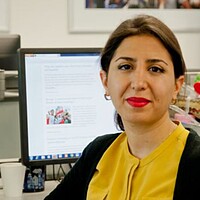'The Arab of the Future 2' sees Syria through the eyes of an outsider
Loading...
In 1984, after taking a summer vacation in France, Riad Sattouf, along with his French mother, Syrian father, and little brother, moves to his father’s village near Homs in Syria. From the moment he enters Syria, he receives a mixed reception; some hail the 6-year-old blond foreigner, while others hate him for being half French and therefore a “Jew.”
Sattouf, a cartoonist and filmmaker who worked for the satirical French weekly Charlie Hebdo for a decade until 2014, was born in Paris in 1978. Soon after he was born, his father, Abdel-Razak, a devout Pan-Arab nationalist, took his family to Libya and then Syria.
Sattouf revisited his memories of the Middle East in the comic-strip series “The Arab of the Future.” The first volume of his memoir (projected to be a five-part project) was published in 2015, and the same year it won a Fauve d’Or prize at France’s Angoulême International Comics Festival. It has since been translated into 16 languages.
Now Sattouf is back with the second volume, The Arab of the Future 2: A Childhood in the Middle East, 1984-1985.
After describing his years in Libya and Syria between 1978 and 1984 in the first volume, he begins the second volume with his family residing in the village of Ter Maaleh, near Homs. Nothing escapes Sattouf’s curious and vigilant eyes. To him, a newcomer, every single detail is worth noting, as it is to the reader.
Sattouf begins observing and learning about Syrian – or better to say Middle Eastern – behaviors. At one point, he is a witness to his father almost getting into a fight with a shopkeeper over paying for a bag. The shopkeeper, as a gesture of generosity, fiercely pushes back the money, saying it’s a gift. In the end, of course, he takes the money.
At school, Sattouf faces surprising and sometimes shocking situations as well. His teacher is a woman who “would always wear a hijab with very short, tight skirts.” She holds a big stick in her hand with which she mercilessly hits disobedient students.
Sattouf’s dark humor is undeniable. He describes the anti-Semitic atmosphere the way it is, without trying to tone things down. Since the story is being narrated by a 6-year-old, this seems more palatable. When Sattouf is accused of being a Jew, he thinks of a way to clear his name. During recess, while children play war against Israel, he tries to be “as aggressive as possible toward the Jews” to prove he isn’t one.
Even Sattouf’s father is not exempt from his sharp-edged satire. Abdel-Razak, who has a doctorate in history from the Sorbonne, is a fierce admirer of Arab nationalism. In the late 1970s, he turns down an Oxford teaching post for one in Libya; in 1984, he moves to Syria to teach at the University of Damascus.
Sattouf talks freely about his father’s naive appreciation for politicians now known as notorious, including Muammar Qaddafi and Hafez al-Assad. Sattouf also doesn’t hesitate to point out his father’s contradictory actions. In France, Abdel-Razak eats pork; in Syria, he observes the Muslim tradition of not eating pork.
The book also depicts the propaganda game going on in Assad’s Syria. As the presidential election approaches, Sattouf’s teacher, who claims that “along with the USSR, Syria is one of the most developed states in the world,” instructs her students that they must tell their parents to vote for Assad.
In addition, Sattouf talks about the common superstitions and cultural beliefs that permeate life and conversation in the Syria of his childhood. These range from a mother who puts onion in her baby’s eyes to improve the child’s eyesight to a story Sattouf’s father told him about how, years earlier, a relative was about to be eaten by a hyena and started reciting the Quran. At that very moment, Sattouf’s father said, the hyena stopped “laughing,” lowered its head, and ran away.
The book also hints at some of the traditions that seem incomprehensible to Westerners. When a widowed relative gets pregnant out of wedlock, the woman’s father and brother kill her to save the family’s honor. They are imprisoned for a short while and then released, becoming “hugely respected men in the village.”
But Sattouf has a smooth and easy style that invites the reader to move through his narration of life in Syria without being judgmental. Of course, reading the first volume in advance would add to the pleasure of reading the second volume; however, “The Arab of the Future 2” is a complete book on its own.
Using the magic of his visual storytelling, Sattouf becomes a darkly humorous, poignant, and vivid guide into the mind of Syrians, if not Middle Easterners, of the recent past.
Denise Hassanzade Ajiri regularly reviews books for The Christian Science Monitor.







